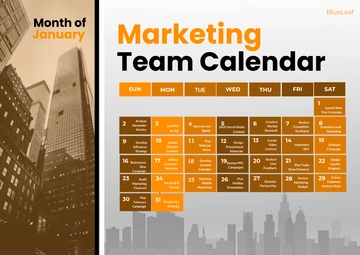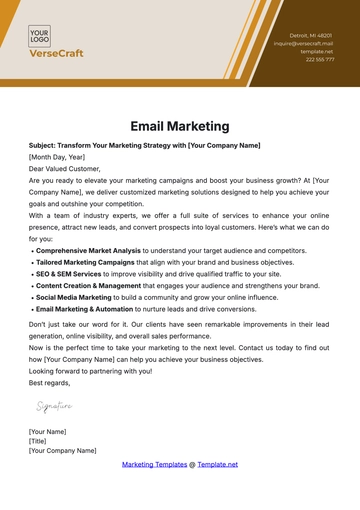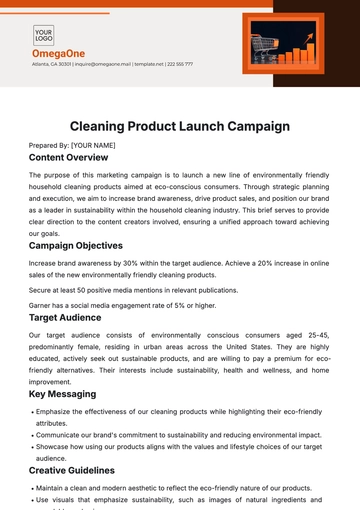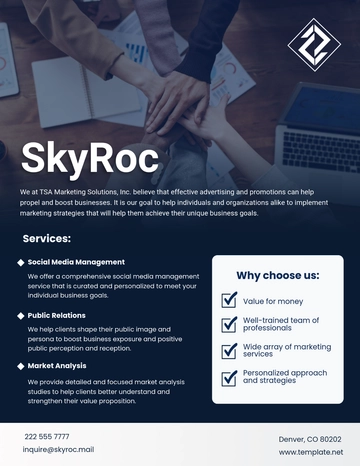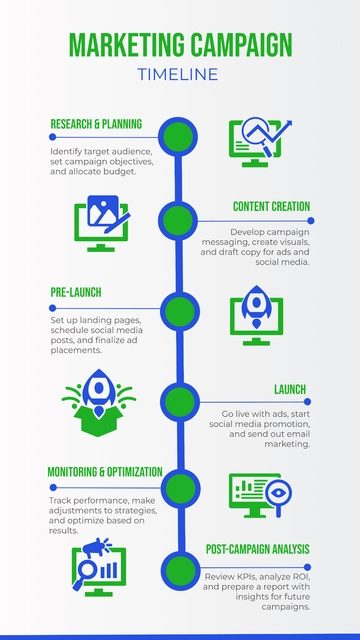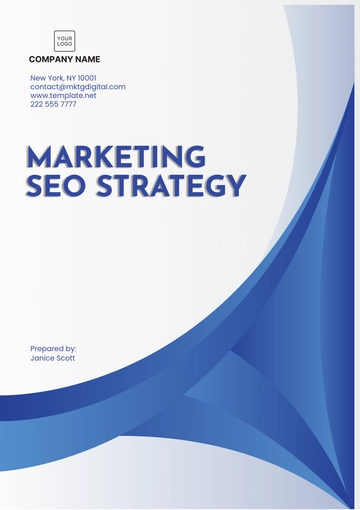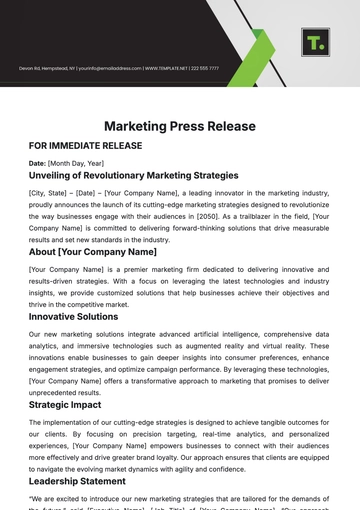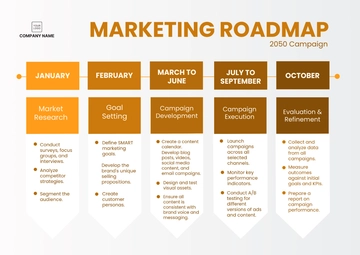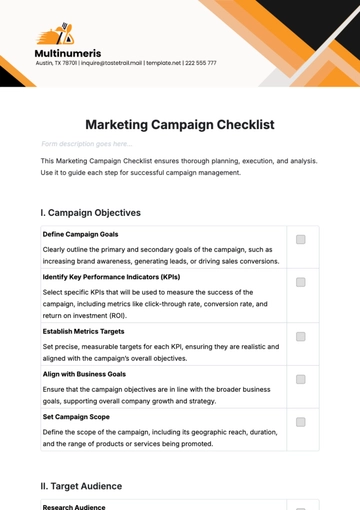Free Marketing Methodology

Prepared By: [Your Name]
Company: [Your Company Name]
1. Introduction
This Marketing Methodology provides a structured approach to planning, executing, and evaluating the launch of a new tech product. The methodology includes specific strategies for market research, campaign planning, execution, and performance measurement, ensuring that the launch is aligned with business goals and maximizes market impact.
2. Market Research
2.1 Objectives
Identify target customers for the new tech product
Assess the competitive landscape in the tech industry
Determine key market trends and consumer preferences
2.2 Methods
Qualitative Research
Focus Groups: Conduct three focus groups with tech enthusiasts and industry experts to gather feedback on product features and potential improvements.
Interviews: Perform in-depth interviews with 10 potential users to understand their needs and pain points related to the product category.
Quantitative Research
Surveys: Distribute an online survey to 500 tech professionals to measure interest in the new product and gather data on preferred features.
Experiments: Test different messaging strategies through A/B testing on email campaigns to determine which resonates best with the target audience.
Secondary Research
Industry Reports: Analyze reports from Gartner and Forrester on current tech market trends and consumer technology adoption rates.
Competitive Analysis: Review competitor product offerings, pricing strategies, and customer reviews to identify gaps and opportunities.
2.3 Data Collection
Online Surveys: Use SurveyMonkey to create and distribute the survey, ensuring a representative sample of tech professionals.
Social Media Analytics: Monitor Twitter and LinkedIn discussions using tools like Hootsuite to gauge sentiment and gather insights on emerging tech trends.
Customer Feedback: Collect feedback from beta testers through a dedicated feedback portal on the company website.
2.4 Analysis
Data Segmentation: Segment survey data by job role, company size, and technology usage to tailor marketing messages effectively.
Trend Analysis: Identify trends such as increasing demand for AI features and integrate these insights into product positioning.
SWOT Analysis: Conduct a SWOT analysis to evaluate the product's strengths, weaknesses, opportunities, and threats in the current market.
3. Strategy Development
3.1 Objectives
Create a comprehensive marketing plan to launch the tech product successfully
Develop targeted strategies to reach key customer segments
Define clear marketing goals and metrics for success
3.2 Components
Market Segmentation
Demographic Segmentation: Target tech professionals aged 25-45 who work in tech companies or startups.
Psychographic Segmentation: Focus on early adopters and tech enthusiasts who value innovation and cutting-edge technology.
Positioning Strategy
Unique Selling Proposition (USP): Highlight the product's advanced AI capabilities and seamless integration with existing tech ecosystems as its unique selling points.
Brand Positioning: Position the product as a premium solution for businesses looking to enhance their technology infrastructure.
Marketing Mix (4Ps)
Product: Feature advanced AI algorithms, user-friendly interface, and high compatibility with other tech products.
Price: Set a competitive price of $499 with introductory discounts and flexible payment options.
Place: Distribute through tech e-commerce platforms, direct sales through the company website, and partnerships with tech retailers.
Promotion: Plan a multi-channel promotional campaign including digital ads, influencer partnerships, and a launch event.
3.3 Strategy Formulation
Component | Details |
|---|---|
Goal Setting | Achieve 10,000 units sold within the first three months of launch, with a 90% or higher customer satisfaction rate. |
Budget Allocation |
|
Timeline |
|
4. Execution Plan
4.1 Objectives
Implement marketing strategies effectively and efficiently
Ensure timely execution of all planned activities
Monitor progress and make necessary adjustments
4.2 Activities
Campaign Development
Creative Design: Develop promotional materials including digital ads, social media graphics, and email templates featuring the product’s key benefits and features.
Media Planning: Select advertising channels such as Google Ads, LinkedIn Ads, and industry-specific tech blogs for targeted reach.
Content Creation
Copywriting: Write compelling content for landing pages, social media posts, and email campaigns focusing on the product's unique features and benefits.
Design: Create visually appealing graphics and videos showcasing the product in action and demonstrating its capabilities.
Campaign Launch
Pre-Launch Activities: Conduct a soft launch with beta testers to gather final feedback and make any necessary adjustments before the official launch.
Launch: Execute the full campaign on the scheduled launch date, including a virtual launch event with live demonstrations and Q&A sessions.
4.3 Coordination
Team Management: Oversee the coordination of tasks among marketing team members, graphic designers, and external partners to ensure smooth execution.
Vendor Management: Collaborate with media buying agencies, creative agencies, and event organizers to manage their roles and deliverables.
5. Performance Measurement
5.1 Objectives
Assess the effectiveness of marketing strategies and tactics
Identify successes and areas for improvement
Provide actionable insights for future marketing activities
5.2 Metrics and KPIs
Sales Metrics
Revenue Growth: Track sales revenue from the product launch and compare it to the forecasted targets.
Conversion Rates: Monitor the conversion rate from marketing leads to actual purchases.
Marketing Metrics
Return on Investment (ROI): Calculate the ROI for each marketing channel to determine cost-effectiveness.
Customer Acquisition Cost (CAC): Measure the average cost of acquiring a new customer through various marketing efforts.
Engagement Metrics
Website Traffic: Analyze changes in website traffic and user behavior related to the product launch.
Social Media Engagement: Track engagement metrics such as likes, shares, and comments on promotional posts.
5.3 Analysis
Data Interpretation: Review performance data to evaluate the effectiveness of marketing activities and identify trends.
Reporting: Prepare detailed reports on campaign performance, including sales data, engagement metrics, and ROI.
Optimization: Recommend adjustments based on performance analysis, such as reallocating the budget to high-performing channels or tweaking messaging strategies.
6. Review and Improvement
6.1 Objectives
Reflect on the outcomes of the product launch
Identify key learnings and areas for enhancement
Implement changes to improve future marketing efforts
6.2 Processes
Post-Campaign Review
Performance Evaluation: Assess the success of the product launch against established goals and metrics.
Lessons Learned: Document insights and lessons learned from the campaign to inform future product launches.
Continuous Improvement
Feedback Collection: Collect feedback from customers, team members, and stakeholders to identify areas for improvement.
Strategy Refinement: Adjust marketing strategies and processes based on feedback and performance results.
Best Practices
Knowledge Sharing: Share successful practices and methodologies with the broader marketing team and organization.
Training and Development: Provide training for marketing teams on new tools, techniques, and industry trends to enhance skills and knowledge.
7. Conclusion
This Marketing Methodology provides a structured framework for launching a new tech product, encompassing thorough market research, strategic planning, and effective execution. It ensures that marketing efforts are well-coordinated and aligned with business goals by utilizing detailed research, targeted strategies, and comprehensive performance measurement. The approach includes assessing market conditions, defining clear marketing goals, executing campaigns efficiently, and continuously improving based on performance insights. This methodology aims to maximize market impact and drive business success by delivering a well-executed and data-driven product launch.
- 100% Customizable, free editor
- Access 1 Million+ Templates, photo’s & graphics
- Download or share as a template
- Click and replace photos, graphics, text, backgrounds
- Resize, crop, AI write & more
- Access advanced editor
The Marketing Methodology Template from Template.net offers an editable and customizable framework for planning and executing marketing strategies. Designed for marketing professionals and teams, this template provides a structured approach to defining goals, selecting methods, and analyzing results. Easily adapt the content to fit your specific campaign needs, ensuring a tailored and effective methodology that drives successful marketing outcomes and strategic insights.
You may also like
- Marketing Google Slide
- Marketing Letter
- Marketing Quotation
- Marketing Report
- Marketing Strategic Plan
- Marketing Plan
- Marketing Proposal
- Marketing Flyer
- Marketing Presentation
- Real Estate Marketing Plan
- Marketing Contract
- Marketing Agreement
- Marketing Resume
- Marketing Checklist
- Marketing Brochure
- Marketing Banner
- Marketing Schedule
- Marketing Vector
- Marketing Logo
- Marketing Chart
- Marketing Campaign Plan
- Marketing Budget
- Marketing Postcard
- Marketing Poster
- Marketing Facebook Post
- Marketing Instagram Post
- Marketing Newsletter
- Marketing Infographic

